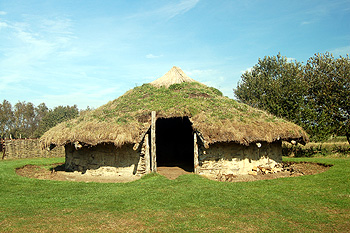Chalgrave in Prehistory

A reconstruction of a Bronze Age round house at Flag Fen October 2011
The Bedfordshire Historic Environment Record [HER] contains information on the county’s historic buildings and landscapes and summaries of each entry can now be found online as part of the Heritage Gateway website. Parts of the modern parish of Chalgrave were occupied at various times during the vast span of years making up prehistory.
The earliest evidence for people in the area dates back to the Middle Stone Age, or Mesolithic Era. Flint tools for scraping as well as flakes and a core from which the flakes were struck have been found on a low ridge south of Manor Farm from field walking [HER 15814]. Field walking south-west of Tebworth has produced some Mesolithic flint flakes [HER 16261]. The area south of Manor Farm has also produced Neolithic tools including flints for piercing and scraping and a Bronze Age dagger.
Near Chalgrave Road, just north of Wingfield field waking has recovered more flint tools dating from the Neolithic and Bronze Age [HER 16268]. It is a common misconception that with the beginning of the Bronze Age flint was no longer used. In fact it was in use for tools throughout the Bronze Age and into the Iron Age because there was a plentiful supply close at hand and the process of making flint tools was much quicker and easier, in skilled hands, than casting something in copper, bronze or iron. More such flint tools were found west of Tebworth and north of Trinity Farm through field walking [HER 16265]
A copper-alloy palstave axe from the middle Bronze Age was discovered east of College Farm in 2011 [HER 19330]. Also possibly Bronze Age were hut circles once visible on Steps Hill and recorded by J. G. Gurney in the first part of the 20th century [HER 11995]. If not Bronze Age the circles were likely Iron Age in date.
South-east of Wingfield a large area of Iron Age and Romano-British occupation has been identified [HER 15811] on south facing slopes through field walking. Broken pottery found here goes right through the Iron Age. More Iron Age pottery, as well as some from the Middle Ages, has been found east of the hamlet of Wingfield [HER 16267]. A late Iron Age brooch was found south-west of Rose Farm in 2004 by a metal detectorist [18818]
Finally, a roughly square enclosure with two lines abutting one corner was identified as a cropmark east of Manor Farm in 1996 [HER 16590]. This is likely of prehistoric date but, without excavation or field walking nothing more definite can be said.